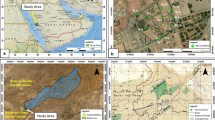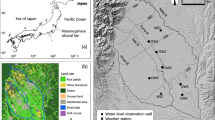Abstract
In this study monthly, annual and seasonal groundwater variation trends of Warangal district (2000–2015) were examined for forty observation wells using four variations of non-parametric Mann Kendal (MK) methods. Magnitudes of trends were computed using the Sen’s slope estimator. Results conclude that on a monthly time series, three observation wells (31, 32 and 37) experienced significant positive trends (positive Z-statistics), whereas other wells experienced significant negative trends among forty. Wells 2, 17, 22, 33, 38, 39, 40 noticed strong significant negative trends. Using MK-1/MK-2/MK-3/MK-4 for monthly series, around 23/33/23/23% of cases exhibited positive trends (both significant and insignificant) and 77/67/77/77 % of cases exhibited negative trends. Median of trend slopes for groundwater levels (GWLs) were negative in monthly, seasonal and annual timescale. Seasonally trend slope was observed as a decreasing trend in the pre-monsoon period. Annually trend slope was varying approximately from −0.4 mm/year to +0.4 mm/year. ARIMA models were fitted for each well to predict the parameters of the models and to forecast (2015) using monthly GWLs from 2000 to 2014. ARIMA(2,1,2), ARIMA(2,0,1), ARIMA(4,0,0), ARIMA(1,1,1), ARIMA(1,0,1), ARIMA(1,0,2) and ARIMA(2,0,0) fitted for most of the Wells. Using these models GWLs were predicted and the performance of the predicted levels was analyzed using the correlation coefficient (R2) and Akaike Information Criteria (AIC) values.
Similar content being viewed by others
References
Abghari, H., Tabari, H. and Talaee, P. H. (2013) River Flow Trends in the West of Iran during the Past 40 years: Impact of Precipitation Variability. Global and Planetary Change, v.101, pp.52–60.
Aslan, S.T.A. and Gundoglu, K.S. (2007) Mapping Multi-Year Groundwater Depth Patterns from Time-Series Analyses of Seasonally Lowest Depth-to-Groundwater Maps in Irrigation Areas. Polish Jour. Environ. Stud., v.16(2), pp.183–90.
Barua, S., Muttil, N., Ng, A.W.M. and Perera, B.J.C. (2013) Rainfall Trend and Its Implications for Water Resource Management within the Yarra River Catchment, Australia. Hydrological Processes v.27(12), pp.1727–38.
Dinpashoh, Y., Mirabbasi, R., Jhajharia, D., Abianeh, H.Z. and Mostafaeipour, A. (2014) Effect of Short-Term and Long-Term Persistence on Identification of Temporal Trends. Jour. Hydrologic Engg., v.19(3), pp.617–25.
Gibrilla, A., Anornu, G. and Adomako, D. (2018) Trend analysis and ARIMA modelling of recent groundwater levels in the White Volta River basin of Ghana. Groundwater for Sustainable Development, v.6, pp.150–163.
Hamed, K.H. (2008) Trend Detection in Hydrologic Data: The Mann-Kendall Trend Test under the Scaling Hypothesis. Jour. Hydrology, v.349(3–4), pp.350–63.
Hamed, K.H. and Rao, A.R. (1998) A Modified Mann-Kendall Trend Test for Autocorrelated Data. Jour. Hydrology, v.204, pp.182–96.
Hirsch, R.M. and Gilroy, E.J. (1985) Detectability of Step Trends in the Rate of Atmospheric Deposition of Sulfate. JAWRA Jour. Amer Water Res. Assoc., v.21(5), pp.773–84.
Hirsch, R.M., Slack, J.R. and Smith, R.A. (1982) Techniques of Trend Analysis for Monthly Water Quality Data. Water Resour. Res., v.18(1), pp.107–21.
Hurst, H. E. (1951) Long-term storage capacity of reservoirs. Trans. Amer. Soc. Civil Engg., v.116, pp.770–808
Kendall, M.G. (1975) Rank correlation methods. Griffin, London.
Khaliq, M.N., Ouarda, T. B.M.J., Gachon, P., Sushama, L. and St-Hilaire, A. (2009) Identification of Hydrological Trends in the Presence of Serial and Cross Correlations: A Review of Selected Methods and Their Application to Annual Flow Regimes of Canadian Rivers. Jour. Hydrology, v.368(1–4), pp.117–30.
Koutsoyiannis, D. (2003) Climate Change, the Hurst Phenomenon, and Hydrological Statistics. Hydrological Sci. Jour., v.48(1), pp.3–24.
Kumar, S., Merwade, V., Kam, J. and Thurner, K. (2009) Streamflow Trends in Indiana: Effects of Long Term Persistence, Precipitation and Subsurface Drains. Jour. Hydrology, v.374(1–2), pp.171–83.
Mann, H.B. (1945) Nonparametric Tests Against Trend. Econometrica, v.13(3), pp.245–59.
Reeves, J., Chen, J., Wang, X.L., Lund, R. and Lu, Q.Q. (2007) A Review and Comparison of Changepoint Detection Techniques for Climate Data. Jour. Appld. Meteorol. Climatol., v.46(6), pp.900–915.
Sen, P.K. (1968) Estimates of the Regression Coefficient Based on Kendall’s Tau. Jour. Amer. Statist. Assoc., v.63(324), pp.1379–89.
Spearman, C. (1904) The Proof and Measurement of Association between Two Things. Amer. Jour. Psychology, v.15(1), pp.72–101.
Tabari, H., Nikbakht, J. and Some’e, B.S. (2011) Investigation of Groundwater Level Fluctuations in the North of Iran. Environ. Earth Sci., v.66(1), pp.231–43.
Tankersley, C.D., Graham, W.D and Hatfield, K. (1993) Comparison of Univariate and Transfer Function Models. Water Resour. Res., v.29(10), pp.3517–33.
Theil, H. (1950a) A rank-invariant method of linear and polynomial regression analysis, I. Proc. K. Ned. Akad. Wet 53, pp.386–392.
Theil, H. (1950b) A rank-invariant method of linear and polynomial regression analysis, II. Proc. K. Ned. Akad. Wet 53, pp.512–525.
Theil, H. (1950c) A rank-invariant method of linear and polynomial regression analysis, III. Proc. K. Ned. Akad. Wet 53, pp.1397–1412.
Vousoughi, D., Farnaz, Y. Dinpashoh, Aalami, M.T. and Jhajharia, D. (2013) Trend Analysis of Groundwater Using Non-Parametric Methods (Case Study: Ardabil Plain). Stochastic Environmental Research and Risk Assessment, v.27(2), pp.547–59.
Yue, S., Pilon, P. and Cavadias, G. (2002) Power of the Mann-Kendall and Spearman’s Rho Tests for Detecting Monotonic Trends in Hydrological Series. Jour. Hydrol., v.259(1–4), pp.254–71.
Yue, S. and Wang, C. Y. (2002) Applicability of Prewhitening to Eliminate the Influence of Serial Correlation on the Mann-Kendall Test. Water Resour. Res., v.38(6), pp.4–1–4–7.
Author information
Authors and Affiliations
Corresponding author
Rights and permissions
About this article
Cite this article
Satish Kumar, K., Venkata Rathnam, E. Analysis and Prediction of Groundwater Level Trends Using Four Variations of Mann Kendall Tests and ARIMA Modelling. J Geol Soc India 94, 281–289 (2019). https://doi.org/10.1007/s12594-019-1308-4
Received:
Accepted:
Published:
Issue Date:
DOI: https://doi.org/10.1007/s12594-019-1308-4




